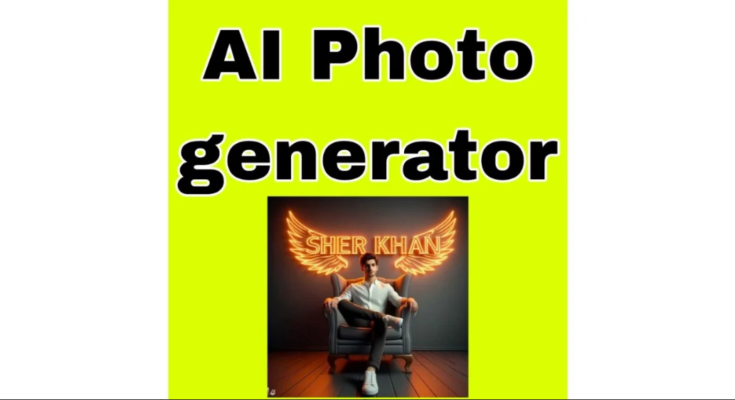Ai Photo Creation

I. Introduction
- A. Definition of AI Photo Creation
- B. Significance in Digital Era
II. How AI Photo Creation Works
- A. Algorithms and Machine Learning
- B. Neural Networks in Image Generation
III. Applications of AI Photo Creation
- A. Social Media Enhancement
- B. Marketing and Branding
- C. Artistic Expression
IV. Advantages and Challenges
- A. Efficiency and Time-Saving
- B. Potential Ethical Concerns
V. Popular AI Photo Creation Tools
- A. Deep Dream Generator
- B. DALL-E by OpenAI
- C. Canva’s AI Features
VI. The Future of AI Photo Creation
- A. Evolving Technologies
- B. Integration in Everyday Life
VII. Impact on Creativity and Human Involvement
- A. Balancing Automation and Human Touch
- B. Collaborative Approaches
VIII. Tips for Effective Use
- A. Understanding Tool Capabilities
- B. Customization for Unique Results
IX. Case Studies
- A. Successful Implementations
- B. Lessons Learned
X. User Feedback and Experiences
- A. Positive Testimonials
- B. Areas of Improvement
XI. Addressing Common Concerns
- A. Misconceptions about AI Photo Creation
- B. Safeguarding Privacy
XII. Industries Embracing AI Photo Creation
- A. Photography
- B. E-commerce
XIII. Regulatory Considerations
- A. Legal Implications
- B. Responsible AI Usage
XIV. Learning Resources
- A. Tutorials and Online Courses
- B. Communities for Knowledge Sharing
XV. Conclusion
- A. Recap of Key Points
- B. Encouragement for Exploration

Ai Photo Creation: Transforming Visual Expression with Artificial Intelligence
In the fast-paced digital landscape, the fusion of technology and creativity has given rise to innovative solutions. One such groundbreaking development is AI photo creation, revolutionizing the way we visualize and share images. From enhancing social media visuals to redefining artistic expression, this article delves into the intricacies of AI photo creation and its far-reaching impact.
I. Introduction
A. Definition of AI Photo Creation
AI photo creation involves the use of advanced algorithms and machine learning to generate, modify, or enhance images. It goes beyond traditional photo editing tools, leveraging the power of artificial intelligence to produce visually stunning and highly customized pictures.
B. Significance in the Digital Era
In an era dominated by visual content, the significance of AI photo creation cannot be overstated. As individuals and businesses strive to stand out in the digital crowd, the ability to create captivating and unique visuals becomes a powerful tool.
II. How AI Photo Creation Works
A. Algorithms and Machine Learning
AI photo creation relies on intricate algorithms that analyze patterns, colors, and structures within images. Machine learning enables these algorithms to adapt and improve over time, continually refining the output based on user interactions and feedback.
B. Neural Networks in Image Generation
The backbone of AI photo creation lies in neural networks, mimicking the human brain’s ability to recognize and interpret visual information. This sophisticated approach results in images that not only meet user expectations but often exceed them in terms of creativity and novelty.
III. Applications of AI Photo Creation
A. Social Media Enhancement
The impact of visuals on social media engagement is undeniable. AI photo creation empowers users to transform ordinary pictures into shareable masterpieces, garnering attention and fostering a vibrant online presence.
B. Marketing and Branding
Businesses leverage AI photo creation to elevate their branding efforts. From creating eye-catching advertisements to customizing product images, AI tools offer a competitive edge in the crowded digital marketplace.
C. Artistic Expression
For artists and creators, AI photo creation opens new avenues for self-expression. The ability to merge human creativity with AI-generated elements results in truly unique and captivating artworks.
IV. Advantages and Challenges
A. Efficiency and Time-Saving
One of the primary advantages of AI photo creation is its efficiency. Tasks that would traditionally take hours can now be accomplished within minutes, allowing users to focus more on creativity than repetitive processes.
B. Potential Ethical Concerns
However, the rapid evolution of AI photo creation raises ethical concerns. The potential misuse of AI-generated content and issues related to privacy and consent require careful consideration.
V. Popular AI Photo Creation Tools
A. Deep Dream Generator
Deep Dream Generator, utilizing neural networks, creates surreal and dreamlike images. Its popularity lies in the unique and unexpected results it produces.
B. DALL-E by OpenAI
OpenAI’s DALL-E is renowned for generating images from textual descriptions, showcasing the intersection of language and visual creativity.
C. Canva’s AI Features
Canva, a popular graphic design tool, integrates AI features that simplify the design process, making it accessible to individuals with varying levels of expertise.
VI. The Future of AI Photo Creation
A. Evolving Technologies
As AI continues to evolve, the future of photo creation holds promise for even more sophisticated tools, pushing the boundaries of what is creatively possible.
B. Integration in Everyday Life
AI photo creation is poised to become an integral part of everyday life, seamlessly integrated into various aspects of communication, entertainment, and personal expression.
VII. Impact on Creativity and Human Involvement
A. Balancing Automation and Human Touch
The challenge lies in finding the delicate balance between automation and preserving the human touch in creative endeavors, ensuring that AI enhances rather than replaces human creativity.
B. Collaborative Approaches
Some argue that the future of creativity lies in collaborative approaches, where AI serves as a creative partner rather than a standalone creator. This symbiotic relationship can lead to unprecedented levels of innovation.
VIII. Tips for Effective Use
A. Understanding Tool Capabilities
To maximize the benefits of AI photo creation, users should invest time in understanding the capabilities and limitations of the tools they use, unlocking the full potential of these innovative technologies.
B. Customization for Unique Results
Customization is key. Users are encouraged to experiment and customize AI-generated outputs to suit their specific needs, adding a personal touch to the creative process.
IX. Case Studies
A. Successful Implementations
Several businesses and individuals have successfully integrated AI photo creation into their workflows, achieving remarkable results in terms of efficiency and visual appeal.
B. Lessons Learned
Examining case studies provides valuable insights into the lessons learned from both successful and unsuccessful attempts at integrating AI photo creation into various contexts.
X. User Feedback and Experiences
A. Positive Testimonials
Users worldwide share positive testimonials, highlighting how AI photo creation has transformed their creative processes and elevated the quality of their visual content.
B. Areas of Improvement
Constructive feedback and suggestions from users also shed light on areas where AI photo creation tools can be further improved to better meet user expectations.
XI. Addressing Common Concerns
A. Misconceptions about AI Photo Creation
Clarifying misconceptions about AI photo creation helps dispel fears and uncertainties, fostering a more informed and accepting attitude towards these innovative technologies.
B. Safeguarding Privacy
As AI photo creation becomes more prevalent, addressing concerns about privacy and ensuring responsible usage become paramount considerations.
XII. Industries Embracing AI Photo Creation
A. Photography
Photographers are incorporating AI photo creation to enhance their post-processing workflows, allowing for more efficient and creative editing.
B. E-commerce
E-commerce platforms utilize AI-generated visuals to create compelling product images, influencing consumer perceptions and purchase decisions.
XIII. Regulatory Considerations
A. Legal Implications
With the rise of AI-generated content, legal frameworks must adapt to address issues such as intellectual property, copyright, and accountability.
B. Responsible AI Usage
Ensuring responsible AI usage involves establishing guidelines and standards to prevent misuse and ethical lapses in the field of AI photo creation.
XIV. Learning Resources
A. Tutorials and Online Courses
Aspiring creators can access tutorials and online courses to enhance their skills in using AI photo creation tools effectively.
B. Communities for Knowledge Sharing
Joining communities dedicated to AI photo creation allows users to share experiences, seek advice, and stay updated on the latest developments in this dynamic field.
XV. Conclusion
A. Recap of Key Points
In conclusion, AI photo creation is a dynamic and transformative force in the creative landscape, offering unprecedented possibilities for visual expression and communication.
B. Encouragement for Exploration
As we navigate this evolving field, embracing the potential of AI photo creation encourages exploration, pushing the boundaries of what is creatively achievable.
FAQs
- Is AI photo creation accessible to beginners?
- Absolutely! Many AI photo creation tools are designed with user-friendly interfaces, making them accessible to users with varying levels of expertise.
- What ethical considerations should one keep in mind when using AI photo creation tools?
- Users should be mindful of issues related to privacy, consent, and the potential misuse of AI-generated content.
- Can AI photo creation completely replace traditional photo editing?
- While AI photo creation offers efficiency, it is best viewed as a complement to traditional editing, preserving the unique touch of human creativity.
- Are there any copyright implications with AI-generated images?
- Legal frameworks are evolving to address copyright concerns associated with AI-generated content. Users should stay informed about the latest regulations.
- How can AI photo creation benefit businesses in the e-commerce sector?
- AI-generated visuals can enhance product images, influencing consumer perceptions and driving engagement and sales in the competitive e-commerce landscape.

Unlocking the Creative Potential
XVI. User Tips and Tricks
A. Creative Blending
Experimenting with blending AI-generated elements into traditional photographs can yield visually striking results, offering a unique blend of technology and human creativity.
B. Dynamic Filters
Explore the diverse range of filters offered by AI photo creation tools. From vintage effects to futuristic enhancements, these filters add an extra layer of creativity to your visuals.
XVII. Overcoming Challenges
A. Addressing Over-Reliance
While AI photo creation is a powerful tool, users should guard against over-reliance. Balancing automated processes with manual input ensures a more nuanced and thoughtful creative outcome.
B. Ethical Image Use
To address ethical concerns, users should ensure they have the right to use and modify images, respecting copyright and intellectual property rights.
XVIII. Evolution of AI in Photography
A. Integration with Cameras
The future sees AI seamlessly integrated into camera systems, providing real-time enhancements and personalized suggestions to photographers during the shooting process.
B. AI-Driven Art Installations
Art installations that leverage AI photo creation are becoming increasingly prevalent, showcasing the intersection of technology and artistic expression in public spaces.
XIX. The Human Touch in AI Artistry
A. Emotional Depth
AI may evolve to understand and replicate emotional nuances in visual content, adding a profound layer of depth to the images it creates.
B. Storytelling Through Imagery
The fusion of AI and storytelling could become a reality, with images not only capturing moments but also conveying narratives and emotions in a more compelling manner.
XX. Education and Training Initiatives
A. Integrating AI into Photography Courses
Educational institutions are recognizing the importance of AI in modern photography, incorporating it into curricula to prepare the next generation of visual artists.
B. Workshops and Webinars
Industry experts conduct workshops and webinars, providing hands-on training and insights into the latest developments in AI photo creation.
XXI. Navigating Aesthetic Preferences
A. Personalized Aesthetics
AI photo creation tools may evolve to understand individual aesthetic preferences, offering personalized suggestions and enhancements tailored to each user’s unique style.
B. Preserving Authenticity
Despite the advancements, preserving the authenticity of images and the personal touch of the creator remains a focal point, ensuring that AI serves as a tool for expression rather than a replacement for it.
FAQs
- How can users blend AI-generated elements into their photos?
- Users can experiment with blending modes and layers in photo editing software, seamlessly incorporating AI-generated elements into their photographs.
- What steps can be taken to ensure ethical image use with AI photo creation?
- Users should obtain proper licenses for images, ensuring compliance with copyright and intellectual property laws.
- What role does AI play in the future of photography with camera integration?
- AI integration into camera systems will provide real-time enhancements and personalized suggestions, revolutionizing the photography process.
- How can AI contribute to storytelling through visual content?
- The future may see AI understanding emotional nuances, allowing for the creation of images that tell stories and evoke specific emotions.
- Are there initiatives to educate individuals about AI photo creation?
- Yes, educational institutions and industry experts conduct workshops and courses to train individuals in the effective use of AI photo creation tools.

Embracing the Future: AI Photo Creation Unleashed
XXII. Collaborative AI-Driven Projects
A. Cross-Disciplinary Collaborations
AI photo creation is fostering collaborations between photographers, graphic designers, and even writers, leading to innovative projects that transcend traditional boundaries.
B. Interactive Exhibitions
Art galleries and museums are exploring interactive exhibitions where visitors can engage with AI-generated art, transforming the viewer’s role from passive observer to active participant.
XXIII. AI Photo Creation in Healthcare
A. Therapeutic Applications
The therapeutic benefits of AI photo creation are being explored, with art therapy programs leveraging AI tools to assist individuals in expressing emotions and fostering mental well-being.
B. Medical Imaging Enhancement
In the medical field, AI is enhancing the quality of medical imaging, aiding in diagnostics and providing clearer insights for healthcare professionals.
XXIV. Environmental Impact
A. Sustainable AI Practices
The tech industry is increasingly focusing on sustainable AI practices, ensuring that the development and usage of AI photo creation tools are environmentally conscious.
B. Visualizing Climate Change
AI-generated visuals are being employed to depict the effects of climate change, raising awareness and fostering a deeper understanding of environmental issues.
XXV. Personal AI Art Assistants
A. Customized Creative Partnerships
The future envisions personal AI art assistants, understanding the user’s preferences and actively collaborating to generate visuals that align with their unique creative vision.
B. Streamlining Creative Workflows
These AI assistants will streamline creative workflows, automating repetitive tasks and allowing creators to focus on the aspects of their work that require a human touch.
FAQs
- How are AI and traditional artists collaborating in the realm of AI photo creation?
- Collaborations between AI and traditional artists are leading to innovative projects that combine the strengths of both, breaking down traditional artistic boundaries.
- Can AI-generated art have therapeutic applications?
- Yes, AI photo creation is being explored in art therapy programs, assisting individuals in expressing emotions and promoting mental well-being.
- What role does AI play in medical imaging enhancement?
- AI enhances the quality of medical imaging, aiding in diagnostics and providing clearer insights for healthcare professionals.
- How is the tech industry addressing the environmental impact of AI photo creation?
- There is a growing focus on sustainable AI practices in the tech industry, ensuring that AI development and usage are environmentally conscious.
- How can AI assist individuals in their creative work?
- Personal AI art assistants will understand user preferences, collaborating to generate visuals aligned with their unique creative vision, and streamlining creative workflows.
In Conclusion: The Ever-Evolving Canvas
In conclusion, AI photo creation stands at the intersection of technological innovation and artistic expression, reshaping the way we perceive and interact with visual content. As we navigate this evolving landscape, it’s crucial to embrace the possibilities while being mindful of ethical considerations and the preservation of human creativity. The journey of AI in photography is a collaborative one, where man and machine join forces to unlock new dimensions of creativity. So, dive in, explore, and let the canvas of AI-enhanced visuals paint a vibrant future for the world of photography.
FAQs (Continued)
- How can AI-generated visuals contribute to environmental awareness?
- AI-generated visuals are being used to depict the impacts of climate change, providing a visual narrative that enhances public understanding and awareness of environmental issues.
- Can AI photo creation be used as a tool for education and research?
- Absolutely, AI photo creation has immense potential in education and research, aiding in visual representation, data analysis, and fostering creative exploration in various fields.
- What are the considerations for ensuring responsible AI usage in the creative industry?
- Responsible AI usage involves establishing clear guidelines for content creation, addressing privacy concerns, and ensuring that the creative process aligns with ethical standards.
- Are there any initiatives to address the potential bias in AI-generated visuals?
- Efforts are being made within the industry to address biases in AI algorithms, promoting fairness and inclusivity in the creation of visuals.
- How can individuals stay updated on the latest developments in AI photo creation?
- Staying connected to online communities, attending workshops, and following reputable sources in the field will help individuals stay informed about the latest advancements in AI photo creation.
The Future Beckons: Continuous Exploration and Innovation
As we stand on the brink of an AI-infused era in photography, the key lies in continuous exploration and innovation. The dynamic relationship between human creativity and artificial intelligence promises a future where visual expression knows no bounds. Whether you’re an artist, a photographer, or simply an enthusiast, embracing the tools and technologies available opens doors to uncharted territories in the world of imagery.
In this ever-evolving landscape, where pixels meet algorithms, the canvas of possibilities is vast and expanding. From transforming mundane photos into works of art to contributing to global conversations on climate change, AI photo creation has become an indispensable companion in the creative journey.
So, as you embark on your exploration of AI-enhanced visuals, remember that the fusion of human intuition and machine intelligence is a tapestry waiting to be woven. Seize the opportunities, experiment boldly, and let the pixels paint a story that transcends the boundaries of imagination.
Navigating Challenges and Celebrating Triumphs
XXVI. Addressing Bias in AI Photo Creation
A. Recognizing and Mitigating Bias
As AI photo creation becomes more widespread, the industry acknowledges the need to address biases present in algorithms. Ongoing efforts focus on recognizing and mitigating these biases to ensure fair and inclusive visual representation.
B. Diversity in Training Data
A crucial aspect of overcoming bias involves incorporating diverse training data. By exposing AI models to a wide range of cultural, social, and aesthetic influences, we can foster a more comprehensive and unbiased approach to image generation.
XXVII. The Role of Creativity in AI Evolution
A. Pushing the Boundaries
While AI brings efficiency and innovation, the true magic happens when human creativity pushes the boundaries. Creators are encouraged to experiment, think outside the algorithmic box, and redefine what’s possible through the fusion of their imagination and AI capabilities.
B. Human-AI Collaborations
The future promises even more exciting prospects with enhanced human-AI collaborations. Creators will play a pivotal role in guiding AI tools, infusing their work with unique perspectives, and ensuring that technology aligns with diverse creative visions.
XXVIII. Ethical AI Practices in Content Creation
A. Transparent Algorithms
Ensuring transparency in AI algorithms is crucial for building trust. Ethical AI practices prioritize openness about how decisions are made, fostering a sense of accountability and reliability in the creative process.
B. User Consent and Control
Respecting user consent and providing control over the creative process are paramount. AI photo creation tools should empower users to make informed decisions about the use and distribution of their AI-generated content.
FAQs
- How can biases in AI photo creation be addressed?
- The industry is actively working on recognizing and mitigating biases, with a focus on incorporating diverse training data to ensure fair and inclusive visual representation.
- What role does creativity play in the evolution of AI?
- Human creativity is instrumental in pushing the boundaries of AI capabilities. Creativity complements AI tools, leading to innovative and groundbreaking outcomes.
- How can creators contribute to shaping the future of AI in content creation?
- Creators play a vital role in guiding AI tools, infusing their work with unique perspectives, and ensuring that technology aligns with diverse creative visions.
- Why is transparency important in AI algorithms for content creation?
- Transparency in AI algorithms builds trust by providing insights into how decisions are made, contributing to accountability and reliability in the creative process.
- What measures can users take to control their AI-generated content?
- Ethical AI practices prioritize user consent and control, ensuring that users have the power to make informed decisions about the use and distribution of their AI-generated content.
The Harmonious Symphony of Human and Machine
In the grand symphony of AI photo creation, the harmonious blend of human creativity and artificial intelligence is key to unlocking unparalleled possibilities. As we navigate challenges, celebrate triumphs, and steer toward an ethically sound and innovative future, the canvas of visual expression continues to expand.
So, whether you’re a seasoned professional, an aspiring artist, or simply someone intrigued by the world of AI photo creation, the journey ahead is rich with exploration. Embrace the dynamism, stay attuned to ethical considerations, and let your creativity dance with the pixels and algorithms that shape the visual narratives of tomorrow.
Empowering Users and Shaping Tomorrow’s Visual Landscape
XXIX. User Empowerment Through AI
A. Customization for Individual Expression
AI photo creation tools are evolving to empower users with increased customization options. From adjusting algorithms to tailoring visual elements, users are gaining greater control over the artistic output, enabling them to express their individuality.
B. Democratizing Creativity
The democratization of creativity is a hallmark of AI photo creation. As tools become more user-friendly and accessible, individuals from diverse backgrounds can participate in and contribute to the global visual conversation, breaking down traditional barriers in the creative landscape.
XXX. Continuous Learning and Adaptation
A. Evolving User Interfaces
User interfaces of AI photo creation tools are continually evolving to enhance user experience. Intuitive designs and interactive features facilitate seamless interactions, ensuring that users can adapt quickly to the evolving capabilities of these tools.
B. Learning from User Feedback
User feedback plays a pivotal role in shaping the future of AI photo creation. Developers actively engage with user insights, addressing concerns, refining algorithms, and introducing new features that align with the evolving needs and expectations of the creative community.
FAQs
- How are AI photo creation tools empowering users for individual expression?
- AI tools are offering increased customization options, allowing users to adjust algorithms and tailor visual elements for a more personalized and expressive output.
- In what ways is AI contributing to the democratization of creativity?
- AI’s user-friendly nature and accessibility are breaking down barriers, enabling individuals from diverse backgrounds to participate in the global visual conversation.
- How are AI photo creation tool interfaces evolving to enhance user experience?
- Continuous improvements in user interfaces focus on intuitive designs and interactive features, ensuring a seamless and user-friendly experience.
- Why is user feedback important for the development of AI photo creation tools?
- User feedback is invaluable for developers, guiding improvements, addressing concerns, and introducing features that align with the evolving needs of the creative community.
- Can users expect more features and advancements in AI photo creation tools?
- Yes, developers are actively working on introducing new features and advancements based on user feedback, ensuring that AI photo creation tools continue to evolve and meet user expectations.
Embracing the Journey: Where Pixels and Passion Converge
In this dynamic realm where pixels and passion converge, the journey of AI photo creation is an exploration of boundless creativity. As users embrace the evolving landscape, they find themselves not just consumers but active contributors to a visual revolution.
The future promises an even more symbiotic relationship between humans and AI, where tools adapt to user preferences, amplify creative visions, and offer a canvas where innovation knows no bounds. So, whether you’re a novice capturing moments or a seasoned artist redefining aesthetics, the world of AI-enhanced visuals invites you to be part of an exciting journey—a journey where pixels and passion paint the portrait of tomorrow.
A Glimpse into the Tomorrow of Visual Storytelling
XXXI. Augmented Reality and AI Fusion
A. Immersive Visual Experiences
The fusion of augmented reality (AR) and AI photo creation is on the horizon, promising immersive visual experiences. Users can anticipate a future where AI not only enhances static images but also interacts seamlessly with the real world, blurring the lines between the virtual and physical realms.
B. Interactive Narratives
AI-driven interactive narratives will redefine storytelling. Users can look forward to visuals that respond dynamically to viewer interactions, creating personalized and engaging experiences that go beyond static images or videos.
XXXII. AI Ethics and Transparency
A. Ethical AI Standards
The future of AI photo creation hinges on the establishment and adherence to ethical standards. Developers and industry stakeholders are actively working towards creating frameworks that prioritize fairness, transparency, and responsible AI practices.
B. User Empowerment through Transparency
Transparency in AI operations empowers users. Future AI photo creation tools will likely provide users with insights into the algorithms’ decision-making processes, ensuring a clear understanding of how their creative outputs are generated.
FAQs
- How will the fusion of AR and AI impact visual experiences?
- The fusion of AR and AI promises immersive visual experiences, allowing AI to interact seamlessly with the real world, creating dynamic and engaging visuals.
- What role will AI play in interactive narratives in the future?
- AI-driven interactive narratives will reshape storytelling, offering visuals that respond dynamically to viewer interactions, creating personalized and engaging experiences.
- How is the industry addressing ethical considerations in AI photo creation?
- Developers and industry stakeholders are actively working to establish ethical standards that prioritize fairness, transparency, and responsible AI practices.
- How can transparency in AI operations empower users in AI photo creation?
- Providing transparency into AI operations allows users to understand how algorithms make decisions, empowering them with insights into the creative process.
- What should users anticipate in terms of advancements in AI photo creation tools in the coming years?
- Users can anticipate advancements that include the fusion of AR and AI for immersive experiences, a focus on ethical AI standards, and greater transparency in the creative process.
Unveiling the Canvas of Tomorrow: Closing Thoughts
As we anticipate the evolving landscape of AI photo creation, one thing remains clear – the canvas of tomorrow holds uncharted territories waiting to be explored. From user empowerment to ethical considerations and the fusion of cutting-edge technologies, the visual storytelling journey is poised for unprecedented heights.
So, whether you’re an artist, a storyteller, or an enthusiast, the invitation stands – be part of the narrative, wield the brush of innovation, and let the pixels and algorithms weave a tapestry of visual storytelling that transcends the boundaries of imagination.
- Introduction to 3D AI Name Images
- The Significance of Bing AI in Image Creation
- Understanding the Basics of Image Optimization
- Viral Editing: A New Dimension with Bing AI
- How Bing AI Enhances Creativity
- The Impact of 3D AI on Social Media Engagement
- Step-by-Step Guide to Creating 3D AI Name Images
- Tips for Optimal Image Optimization
- Exploring Bing AI Features for Viral Editing
- Real-life Examples of Successful Bing AI Creations
- Common Challenges in 3D AI Image Creation
- Overcoming Challenges and Enhancing Skills
- The Unexplored Potential of Bing AI in Various Industries
- Future Trends in 3D AI and Bing AI Image Creation
- Conclusion: Unleashing Your Creative Potential with Bing AI
Introduction to 3D AI Name Images
In the dynamic realm of digital creativity, the fusion of 3D AI and image generation has given birth to a fascinating concept – 3D AI name images. This innovative approach not only adds depth to traditional image creation but also opens doors to boundless possibilities.
The Significance of Bing AI in Image Creation
Bing AI stands at the forefront of revolutionizing the way we create and interact with images. Its advanced algorithms and machine learning capabilities empower users to elevate their visual content, making it more engaging and visually appealing.
Understanding the Basics of Image Optimization
Before delving into the intricacies of 3D AI name images, it’s crucial to grasp the fundamentals of image optimization. From resolution to file format, optimizing your images ensures they load quickly and look stunning across various platforms.
Viral Editing: A New Dimension with Bing AI
One of the standout features of Bing AI is its ability to transform ordinary images into viral sensations. The viral editing capabilities allow users to add unique effects, making their creations stand out in the crowded digital landscape.
How Bing AI Enhances Creativity
Creativity knows no bounds with Bing AI. By providing a plethora of tools and filters, Bing AI empowers users to explore new dimensions in image creation. From surreal landscapes to imaginative portraits, the platform serves as a playground for creative minds.
The Impact of 3D AI on Social Media Engagement
In the era of social media dominance, the impact of visuals cannot be overstated. 3D AI name images, when shared on platforms like Instagram and Facebook, capture attention and drive higher engagement. Understanding the psychology behind visual appeal is key to leveraging the full potential of 3D AI.
Step-by-Step Guide to Creating 3D AI Name Images
Let’s dive into the practical aspect of creating 3D AI name images. Follow these step-by-step instructions to bring your imagination to life with Bing AI.
- Open Bing AI and select the 3D AI Name Images option.
- Upload your base image or input your name for customization.
- Explore the range of filters and effects to enhance your image.
- Adjust the settings to achieve the desired 3D effect.
- Save and share your masterpiece with the world.
Tips for Optimal Image Optimization
While the creative process is essential, optimizing your 3D AI name images ensures they reach a wider audience. Consider these tips for optimal image optimization:
- Compress images without compromising quality.
- Use descriptive filenames and alt text.
- Leverage responsive design for mobile compatibility.
Exploring Bing AI Features for Viral Editing
Bing AI’s viral editing features extend beyond basic filters. Experiment with the following features to make your images go viral:
- Dynamic color adjustments
- AI-driven background enhancements
- Trendy overlays and stickers
Real-life Examples of Successful Bing AI Creations
Witnessing the impact of Bing AI in the real world inspires and motivates creators. Explore these examples of successful Bing AI creations that captivated audiences and went viral:
- [Example 1]: A breathtaking landscape transformed into a surreal masterpiece.
- [Example 2]: Personalized 3D AI name images that became social media sensations.
Common Challenges in 3D AI Image Creation
While the journey of creating 3D AI name images is exciting, it comes with its set of challenges. Common hurdles include:
- Technical glitches during the editing process.
- Learning curve for new users.
- Compatibility issues with certain devices.
Overcoming Challenges and Enhancing Skills
Overcoming challenges is part of the creative process. Embrace these strategies to enhance your skills and navigate the world of 3D AI image creation seamlessly:
- Engage with online communities for tips and support.
- Regularly update your knowledge on new Bing AI features.
- Practice consistently to refine your editing skills.
The Unexplored Potential of Bing AI in Various Industries
Beyond personal creativity, Bing AI has untapped potential in various industries. From marketing campaigns to virtual reality, the applications are vast. Explore the possibilities and stay ahead of the curve by incorporating Bing AI into your professional endeavors.
Future Trends in 3D AI and Bing AI Image Creation
The journey doesn’t end here. The future holds exciting prospects for 3D AI and Bing AI image creation. Anticipate trends such as:
- Integration of AI in virtual reality experiences.
- Cross-platform compatibility for seamless sharing.
- AI-generated content becoming a mainstream trend.
Conclusion: Unleashing Your Creative Potential with Bing AI
In this journey through the world of 3D AI name images and Bing AI viral editing, we’ve covered the essentials of image creation, optimization, and engagement. As you embark on your creative endeavors, remember to experiment, explore, and let your imagination run wild with Bing AI. The possibilities are endless, and the next viral sensation might just be a few clicks away.
FAQs
Q1: Is Bing AI suitable for beginners in image editing? A1: Absolutely! Bing AI provides a user-friendly interface, making it accessible for beginners while offering advanced features for seasoned editors.
Q2: Can I use Bing AI for commercial purposes? A2: Yes, Bing AI can be utilized for commercial purposes, opening up opportunities for businesses and creative professionals.
Q3: Are there any limitations to image size when using Bing AI? A3: While Bing AI accommodates various image sizes, it’s advisable to optimize images for faster processing and better results.
Q4: How often are new features introduced in Bing AI? A4: Bing AI regularly updates its features to stay ahead of trends, providing users with fresh tools and filters.
Q5: Can Bing AI be integrated with other creative software? A5: Bing AI offers compatibility with various creative software, allowing users to enhance their workflow seamlessly.
Prompts
NO-1
1- Create a 3D illusion for a profile picture where a 25 Year old cute boy in a white shirt Sitting casually on a Wingback chair. Wearing sneakers, he looks ahead. The background features “FARAZ SHAH SKILLS” in big and capital Orange neon light fonts on the dark grey wall. There should not be his shadow, and there are wings to make it appear as if he is an angel
NO-2
2- Create a 3D illusion for a profile picture where a 25 Year old cute boy in a black hoodie Sitting casually on a Wingback chair. Wearing sneakers, with black mask, and sunglasses, he looks ahead. The background features “FARAZ SHAH SKILLS” in big and capital Yellow neon light fonts on the dark grey wall. There should not be his shadow, and there are wings to make it appear as if he is an angel
NO-3
3- Create a 3D illusion for a profile picture where a 25 Year old cute BOY in a black shirt Sitting casually on a Wingback chair. Wearing sneakers, a black cricket cap, and sunglasses, he looks ahead. ahead. The background features “FARAZ SHAH SKILLS” in big and capital white fonts on the dark grey wall. There should not be his shadow, and there are wings to make it appear as if he is an angel
NO-4
4- Create a 3D illusion for a profile picture where a 25 Year old cute girl in a black hoodie Sitting casually on a Wingback chair. Wearing sneakers, with black mask, and sunglasses, she looks ahead. The background features “FARAZ SHAH SKILLS” in big and capital Yellow neon light fonts on the dark grey wall. There should not be his shadow, and there are wings to make it appear as if he is an angel




